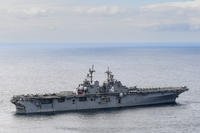Axe is in Lebanon. So he's not around to give his Pop Sci cover story, "Semper Fly," a proper shout-out. Allow me. The Marines have typically been the American military's emergency fighter, its "911 force," the guys you want to get to a trouble zone, ASAP. But these days, getting overflight rights and managing logistics right can slow things to a crawl. So a bunch of waaaay out-of-the-box-thinkin' Marines have come up with an almost insanely ambitious new plan: send squads through space, instead. The concept is called "Small Unit Space Transport and Insertion," or SUSTAIN.
The Marines have typically been the American military's emergency fighter, its "911 force," the guys you want to get to a trouble zone, ASAP. But these days, getting overflight rights and managing logistics right can slow things to a crawl. So a bunch of waaaay out-of-the-box-thinkin' Marines have come up with an almost insanely ambitious new plan: send squads through space, instead. The concept is called "Small Unit Space Transport and Insertion," or SUSTAIN.
Each Sustain lander is intended to hold a squad of 13 Marines. Mounted on wedge-shaped carrier aircraft, the lander would detach, climb, and accelerate with scramjet engines to 100,000 feet and then fire rocket engines to get above 50 miles, following an arc over hostile countries. Composite shields would absorb or deflect the searing heat of reentry as the vehicles angle for the landing zone.
Lafontant arrived at this Space Marines vision after years of analyzing military space needs. A 44-year-old Queens, New York, native who joined the Corps in 1984 as an infantry officer and progressed through Naval Postgraduate School in Monterey, California, where he studied space systems operations and joined the small fraternity of Marine Space Operations Officers. In 2001 he took a job in the Pentagon working for the National Reconnaissance Office. He was serving as liaison to the Joint Chiefs of Staff in November 2001 when the Marine Corps launched its deepest air assault ever.
Five hundred Marines from the 15th Marine Expeditionary Unit prepared to fly 441 miles through the mountains of northern Pakistan in CH-53E Sea Stallion helicopters to capture an airstrip near Kandahar, Afghanistan. It was to be the beginning of the first large offensive against the Taliban and Al Qaeda. If all went well, the Marines expected to walk away with Osama bin Laden.
But political considerations sabotaged the mission. For weeks, the Marines had bobbed on the Indian Ocean aboard two assault ships while State Department officials negotiated with Pakistan for the right to fly through the countrys airspace. Pakistan granted access only after winning economic and military concessions that, some say, have reinforced a repressive regime. When U.S. troops finally touched down on November 25, bin Ladens trail was cold. We ended up selling our soul to the devil to get through, Lafontant says. He grew determined to find a way around that sort of diplomatic entanglement. What if we dont have to have anybodys permission? he asked himself. What if we just go above and drop in?
Now, David just loves this idea. But he knows it's pretty damn far-fetched. He does a good job at laying out the obstacles to making SUSTAIN happen. Not just the extremely high technical hurdles; the Marines' total and utter lack of funds for the project, too. He warps up his story on a balanced note:
Whether or not Sustain ever makes it past the concept stage, its clear that military planners are looking to increase the mobility of American forces. A Marine space transport one that would reduce politically charged bureaucratic delays and the potential for mission snafus might sound impossible, but to Lafontant and others entrusted with imagining the future of war, it is simply the next logical step.








